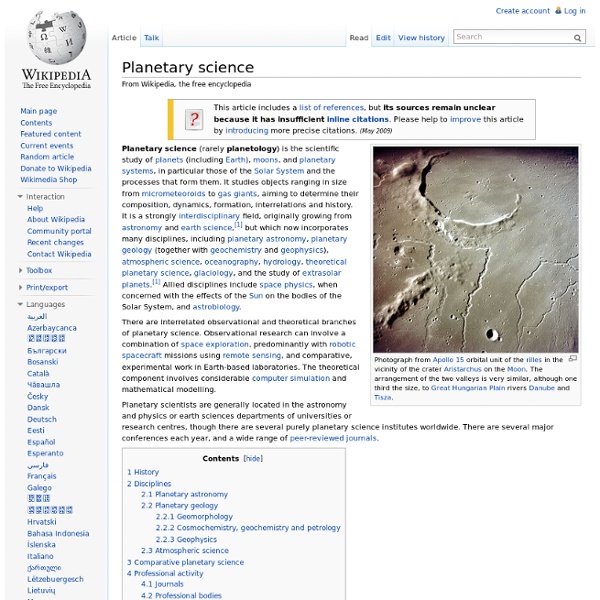High-energy astronomy
High energy astronomy is the study of astronomical objects that release EM radiation of highly energetic wavelengths. It includes X-ray astronomy, gamma-ray astronomy, and extreme UV astronomy, as well as studies of neutrinos and cosmic rays. The physical study of these phenomena is referred to as high-energy astrophysics.[1] Astronomical objects commonly studied in this field may include black holes, neutron stars, active galactic nuclei, supernovae, supernova remnants, and Gamma ray bursts. Missions[edit] Some space and ground based telescopes that have studied high energy astronomy include the following:[2] External links[edit] References[edit]
Plasma (physics)
Plasma (from Greek πλάσμα, "anything formed"[1]) is one of the four fundamental states of matter (the others being solid, liquid, and gas). When air or gas is ionized plasma forms with similar conductive properties to that of metals. Plasma is the most abundant form of matter in the Universe, because most stars are in plasma state.[2][3] Artist's rendition of the Earth's plasma fountain, showing oxygen, helium, and hydrogen ions that gush into space from regions near the Earth's poles. Plasma is loosely described as an electrically neutral medium of positive and negative particles (i.e. the overall charge of a plasma is roughly zero). The plasma approximation: Charged particles must be close enough together that each particle influences many nearby charged particles, rather than just interacting with the closest particle (these collective effects are a distinguishing feature of a plasma). Range of plasmas. For plasma to exist, ionization is necessary.
Gravitation
Gravitation, or gravity, is a natural phenomenon by which all physical bodies attract each other. It is most commonly recognized and experienced as the agent that gives weight to physical objects, and causes physical objects to fall toward the ground when dropped from a height. During the grand unification epoch, gravity separated from the electronuclear force. Gravity is the weakest of the four fundamental forces, and appears to have unlimited range (unlike the strong or weak force). The gravitational force is approximately 10-38 times the strength of the strong force (i.e., gravity is 38 orders of magnitude weaker), 10-36 times the strength of the electromagnetic force, and 10-29 times the strength of the weak force. History of gravitational theory Scientific revolution Modern work on gravitational theory began with the work of Galileo Galilei in the late 16th and early 17th centuries. Newton's theory of gravitation Equivalence principle Formulations of the equivalence principle include:
Space physics
History[edit] In the late 1870s, Henri Becquerel offered the first physical explanation for the statistical correlations that had been recorded: sunspots must be a source of fast protons. They are guided to the poles by the Earth's magnetic field. In the early twentieth century, these ideas led Kristian Birkeland to build a terella, or laboratory device which simulates the Earth's magnetic field in a vacuum chamber, and which uses a cathode ray tube to simulate the energetic particles which compose the solar wind. A theory began to be formulated about the interaction between the Earth's magnetic field and the solar wind. See also[edit] References[edit] Kallenrode, May-Britt (2004).
Physical cosmology
Physical cosmology is the study of the largest-scale structures and dynamics of the Universe and is concerned with fundamental questions about its formation, evolution, and ultimate fate.[1] For most of human history, it was a branch of metaphysics and religion. Cosmology as a science originated with the Copernican principle, which implies that celestial bodies obey identical physical laws to those on Earth, and Newtonian mechanics, which first allowed us to understand those physical laws. Physical cosmology, as it is now understood, began with the development in 1915 of Albert Einstein's general theory of relativity, followed by major observational discoveries in the 1920s: first, Edwin Hubble discovered that the Universe contains a huge number of external galaxies beyond our own Milky Way; then, work by Vesto Slipher and others showed that the universe is expanding. Cosmology draws heavily on the work of many disparate areas of research in theoretical and applied physics. with
Astronomy
Astronomy is a natural science that is the study of celestial objects (such as moons, planets, stars, nebulae, and galaxies), the physics, chemistry, and evolution of such objects, and phenomena that originate outside the atmosphere of Earth, including supernovae explosions, gamma ray bursts, and cosmic background radiation. A related but distinct subject, cosmology, is concerned with studying the universe as a whole.[1] Astronomy is one of the oldest sciences. Prehistoric cultures have left astronomical artifacts such as the Egyptian monuments and Nubian monuments, and early civilizations such as the Babylonians, Greeks, Chinese, Indians, Iranians and Maya performed methodical observations of the night sky. However, the invention of the telescope was required before astronomy was able to develop into a modern science. During the 20th century, the field of professional astronomy split into observational and theoretical branches. Etymology[edit] History[edit] Scientific revolution[edit]



